Einleitung
Das neueste MacBook Pro von Apple ist das bisher schnellste mit einem optionalen Achtfach-Prozessor - dem ersten in einem MacBook - und einem mysteriösen neuen Tastaturmaterial. Da es unwahrscheinlich ist, dass Apple näher auf dieses "Material" eingehen wird, und wir uns grundsätzlich nicht mit ungelösten Rätseln zufrieden geben, ist es wieder mal Zeit, einen genaueren Blick auf die berühmt-berüchtigte Butterfly-Tastatur zu werfen. Also: Aktiviere deine Spürnase und schnüffel' mit uns in diesem neuen Gerät herum!
Du willst noch spannendere Teardown-Rätsel lösen? Folge uns auf Facebook, Instagram und Twitter, da bekommst du alle aktuellen News zu unseren Teardowns. Du willst die News lieber direkt an die Tür geliefert haben? Kein Problem! Abonniere einfach unseren Newsletter.
Werkzeuge
-
-
Auf dem Papier sieht es ja so aus als sei dieses neue MacBook Pro 2019 der neue Tech-nick - aber erfindet der sich wirklich neu oder hat er schon ausgenickt bevor er richtig angefangen hat? Der technische Stand der Dinge laut Apple:
-
15,4-Zoll-IPS-Retina-Display mit LED-Hintergrundbeleuchtung und True Tone-Funktion, 2880 x 1800 Auflösung (220 dpi), P3-Farbskala
-
6-Core Intel Core i7 mit 2,6 GHz (Turbo Boost bis 4,5 GHz) gepaart mit einer Radeon Pro 555X
-
16 GB DDR4-SDRAM mit 2400 MHz
-
256 GB PCIe-basierte SSD
-
802.11ac WLAN und Bluetooth 5.0
-
Vier Thunderbolt 3 (USB-C) -Anschlüsse
-
-
-
Ganz im Stil von Jean Pütz haben wir da mal was vorbereitet und - voilà! Der Mac ist offen!
-
Tatsächlich liegen die Neuerungen wohl hauptsächlich in der innliegenden Tech-Nick - die Hardware ist optisch kaum zu der vom letzten Modell zu unterscheiden. Ziehen wir mal das Motherboard raus und schauen uns das genauer an.
-
-
-
Da sind überhaupt keine modularen Komponenten drauf - Du hast also keine Chance, die Hardware jemals aufzurüsten. So mögest du jetzt sprechen oder für immer mit den Chips klarkommen, die eingebaut sind:
-
Intel Core i7-9750H 6-Core-Prozessor der 9. Generation
-
16x SK Hynix H5AN8G8NAFR 8-GB-DDR4-SDRAM (insgesamt 16 GB)
-
AMD Radeon Pro 555X GPU
-
4x Micron MT51J256M32HF-70: B 8 Gb GDDR5-RAM (insgesamt 4 GB)
-
Apple T2 APL1027 339S00533 Coprozessor, geschichtet über 1 GB Micron D9VLN LPDDR4-Speicher
-
Toshiba TSB3226AW8815TWNA1 und TSB3226XZ2939TWNA1 Flash-Speicher (insgesamt 256 GB)
-
Intel JHL7540 Thunderbolt 3 Controller
-
-
-
Und noch mehr Chips zum Nachschnüffeln:
-
Intel SR40F Plattform-Controller-Hub
-
Texas Instruments CD3215C00Z (wahrscheinlich Leistungsregler)
-
338S00267-A0 (wahrscheinlich Apple PMIC)
-
TPS51980A Leistungsregler
-
339S00458 (wahrscheinlich Apple WLAN / Bluetooth-Modul)
-
Intersil 6277A PWM-Modulator
-
Cirrus Logic CS42L83A Audio-Codec
-
-
-
Und jetzt endlich weiter zur Tastatur! Hier mal die Zusammenfassung der bisherigen Metamorphose dieses Schmetterlings:
-
Nachdem die Schmetterlingstastatur ihre Premiere im Retina MacBook2015 gefeiert hatte, kam sie 2016 erstmals auch in der MacBook Pro Linie zum Einsatz.
-
Mit einiger Verspätung gab Apple im Sommer 2018 die Fehler zu, dabei gaben sie dem Staub die Schuld am Klemmen der Tasten. Kurz darauf wurden die aktualisierten Modelle mit einer zusätzlichen Silikonmembran zum Schutz der Tastenschaltungen veröffentlicht (mittleres Bild). Aber die Probleme waren damit nicht aus der Welt.
-
Zuletzt wurde die Butterfly-Tastatur jetzt 2019 überarbeitet, dabei wird nach wie vor die Silikonmembran verwendet, aber auch die Materialien in der federnden Metallkuppel und in deren plastikartigem Überzug überarbeitet.
-
-
-
Jetzt, da wir das Ganze ein bisschen geschichtlich eingeordnet haben, wollen wir mal Schicht für Schicht durch die butterweichen Komponenten dieser 2019er Tastatur schneiden:
-
Bedeckt wird das Ganze durch die Tastenkappe. Diese hat ein praktisches Etikett, damit der Betroffene gleich weiß, welche Taste kaputt ist.
-
Die klappbare weiße Halterung ist der "Butterfly"-Mechanismus, der die Bewegung der Taste steuert und sie so stabilisiert, dass sie beim Anschlag nicht wackelt oder verkantet.
-
In diese Halterung integriert ist eine transparente Abdeckung, die sich bei jedem Tastendruck biegt und gleichzeitig Verunreinigungen vom darunter liegenden Kuppelschalter fernhält. Der schwarze Punkt in der Mitte bündelt die Kraft des Tastendrucks auf den Schalter.
-
Der Hauptbestandteil dieser Baugruppe ist der federnde Metallkuppelschalter. Er verformt sich, wenn die Taste gedrückt wird, überbrückt die sechs Kontakte der Platine und federt dann zurück, wenn die Taste wieder losgelassen wird.
-
Unter dem Kuppelschalter befinden sich sechs Metallpads. Wenn das obere mittlere Pad mit einem der anderen fünf Pads kurzgeschlossen wird, wird ein Tastendruck registriert.
-
Zu guter Letzt bedeckt die Silikonmembran den Butterfly-Mechanismus, damit keine Fremdkörper eindringen und die Taste blockieren können.
-
-
-
Also, was hat sich dieses Jahr geändert? Zunächst einmal das transparente Material der Schalterabdeckung.
-
Die Abdeckung im 2018er-Modell 2018 ist halb durchsichtig, etwas klebrig und fühlt sich an wie Silikon. Das neue Modell ist transparenter und weicher anzufassen.
-
Um zu bestätigen, dass die Materialien tatsächlich unterschiedlich sind, haben wir sie mit Hilfe der Fourier-Transformations-Infrarot (FTIR)-Spektroskopie analysiert. Vielen Dank an Eric Beaton und den gesamten Fachbereich für Materialtechnik der Cal Poly Hochschule für ihre Ausrüstung und ihr Fachwissen!
-
Da sich die Ausschläge nach oben und unten auf den FTIR-Spektren der beiden Proben unterscheiden, können wir davon ausgehen, dass es sich um unterschiedliches Material handelt. Aber was für Material?
-
Beim Vergleich der FTIR-Spektren mit denen bekannter Polymere ist das 2018er-Modell am ehesten mit Polyacetylen mit aromatischen Urmethan-Seitengruppen vergleichbar, noch mehr Übereinstimmungen finden sich mit einer Art TPU. Beim 2019er-Modell wird Polyamid (besser bekannt als Nylon) verwendet.
-
-
-
Was hat sich sonst noch geändert? Vielleicht der Metall-Kuppelschalter? Schau'n wir mal genauer drauf:
-
Der Schalter ähnelt dem Deckel eines Marmeladeglases - er springt wieder hoch, wenn man ihn runterdrückt.
-
Wenn sich am Schalter etwas ändert, wenn er beispielsweise eingerissen oder verformt ist, wird die Taste unberechenbar. Ebenso, wenn die Zinken brechen oder sich verbiegen, dann hört die Taste ganz auf zu funktionieren.
-
Es ist auch durchaus möglich, dass eine Kombination aus mehreren dieser Faktoren zum Ausfall des Schalters führen könnten, was erklären könnte, warum Apple sich so schwer damit tut, das Problem zu lösen. Vielleicht sind ja aller guten Dinge...vier?
-
-
-
Und das war's auch schon!
-
Zumindest vorläufig. Wenn du zufällig Materialingenieur bist, würden wir gerne auch noch deine Meinung dazu hören und wir würden auch noch gern einen Blick auf alle ausgefallenen Tasten werfen, die wir in die Finger bekommen können.
-
Und damit kannst du dir wahrscheinlich auch schon denken, wo dieser Laptop auf der Reparierbarkeitsskala landet...
-
-
-
Das 2019er MacBook Pro 15" mit Touch Bar erhält 1 von 10 Punkten auf unserer Reparaturfähigkeitsskala (10 ist am einfachsten zu reparieren):
-
Das Trackpad kann ohne viel Theater entfernt und ausgetauscht werden.
-
Prozessor, RAM und Flash-Speicher sind mit dem Logic Board verlötet. Reparaturen und Upgrades sind im besten Fall unpraktisch.
-
Das obere Gehäuse umfasst die Tastatur, den Akku, Lautsprecher und Touch Bar. Alles ist als eine Baugruppe miteinander verklebt, so dass keine dieser Komponenten separat ausgetauscht werden kann.
-
Der Touch-ID-Sensor dient gleichzeitig als Netzschalter und ist mit dem T2-Chip auf dem Logic Board gekoppelt. Wenn der Netzschalter kaputt ist, muss also entweder ein Apple-Techniker ran oder gleich das ganze Logic Board ausgetauscht werden.
-
27 Kommentare
“When comparing these FTIR spectra to that of known polymers, the closest match for the 2018 model is polyacetylene with aromatic urethane side groups, while the 2019 model uses polyamide (commonly known as nylon).
What this doesn't tell us is, just what problem Apple's engineers tried to solve using this updated material. Send us your ideas!”
Spitballing, any debris would have an easier time sliding through the nylon, while the 2018 model has a more sticky material.
tipoo -
Hopefully making cleaning with canned air more effective.
Mark -
The plastic dome covers the contacts so you can’t really blow air into the gap. The covers are glued down to the base 360 degrees.
Dan -
Was eagerly anticipating this teardown as soon as the tech press announced the new MacBook Pros with yet another keyboard iteration.
Question: How are the butterfly mechanism and plastic cover attached to the top case? Are they merely held in place by the silicone membrane?
I could not tell if the membrane had to be cut in order to extract the butterfly mechanism and plastic dome.
Those two keys you disassembled, can they be re-assembled and have them function normally without the key falling off?
The thing that really holds it all together is the clear plastic cover piece with the black dot in the middle. That component both holds the dome in place on the PCB and provides the pivot points for the hinged white bracket that controls the keycap travel. Unfortunately, it’s essentially riveted in place from the back with plastic pegs, and prying it out is usually pretty destructive. (In other words, don’t try this at home!) The silicone dust membrane doesn’t have to be cut however, as it’s mainly around the perimeter and not over the top of the mechanism.
Top side of the dome is pictured in Step 8. ;)
I guess we’ll need to wait another year before we get the old reliable keyboards back! So sad …
Dan -
You’re quite the optimist there.

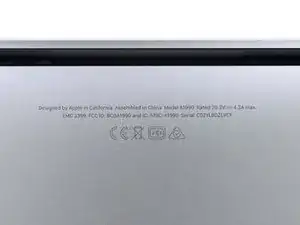
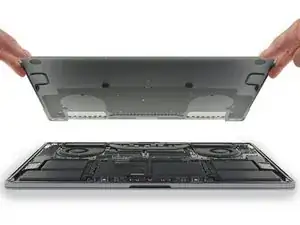
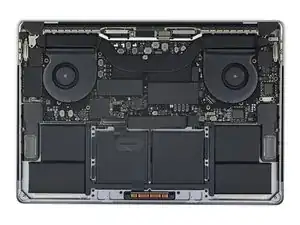
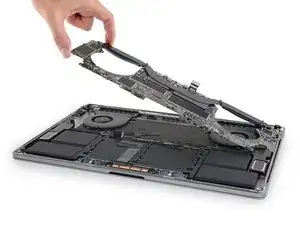
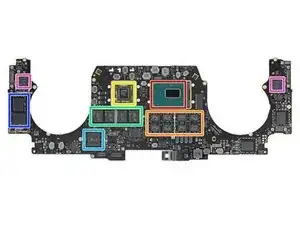
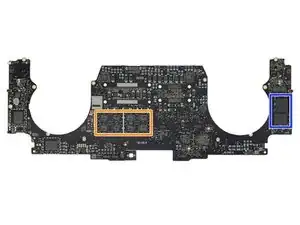
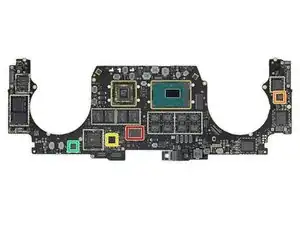
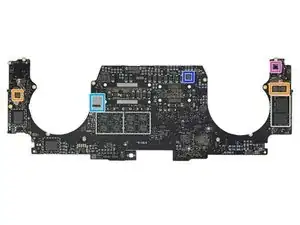
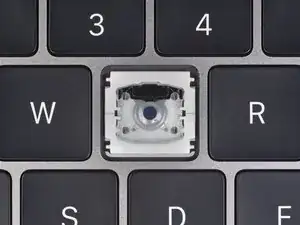
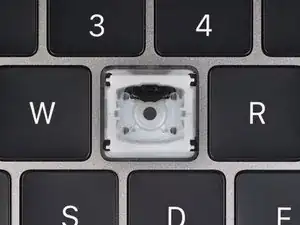
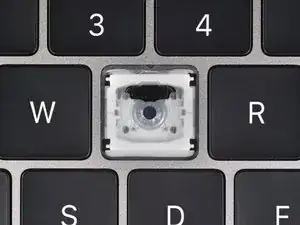
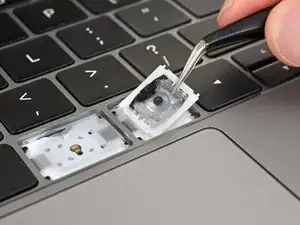
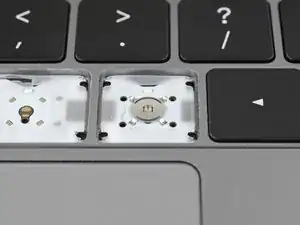
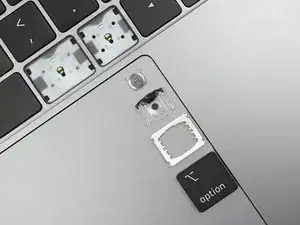
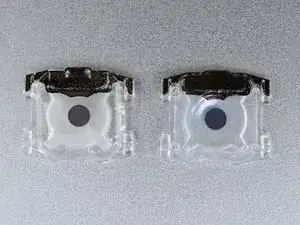
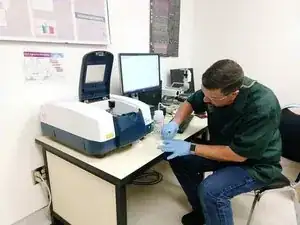
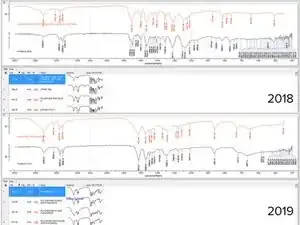
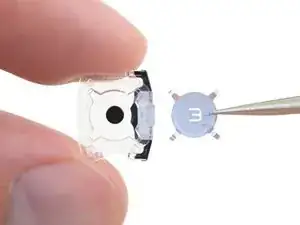
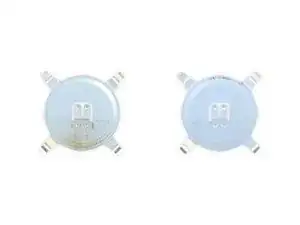
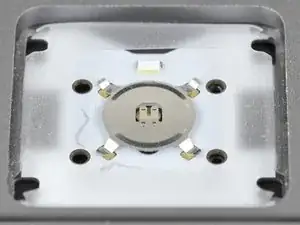
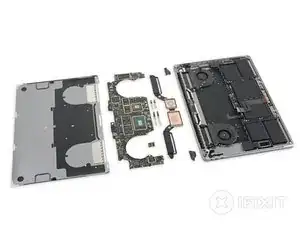
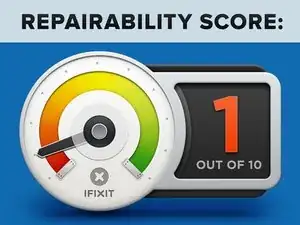

I have found apple products very robust for my business. I work on heavy web design and ``Graphic Design`` work with no problems. In some cases I had to upgrade to more RAM or to SSD disk form buying products from ifixit.com and that extended the life of my MACs even more. I have an Imac and a mac book pro for more than 10 years now.
JCSL -